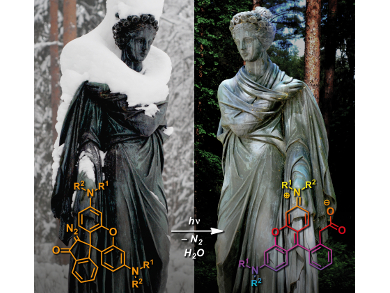A series of masked fluorophores with a 2-diazo-1-indanone group, i.e., caged rhodamine dyes, have been prepared. Initially these dyes are non-colored (pale yellow) and non-fluorescent. They can be unmasked either by irradiation with UV or violet light in a one-photon process, or by exposure to intense red light in a two-photon mode, after which they are highly colored and fluorescent.
Vladimir N. Belov and Stefan W. Hell, Max Planck Institute for Biophysical Chemistry, Göttingen, Germany, in collaboration with Mariano L. Bossi, Universidad de Buenos Aires & Conicet, Argentina, have shown that the dyes can be used as fluorescent markers in subdiffractional and conventional microscopy. The dyes bear linkers that can be used in protein conjugation.
The researchers believe that in combination with site-specific labeling protocols, these novel cell-permeable, caged fluorescent dyes may extend the set of live-cell labeling strategies based on binding genetically encoded protein tags with organic fluorophores. However, this is just one of the many possible applications of these dyes.
- Masked Rhodamine Dyes of Five Principal Colors Revealed by Photolysis of a 2-Diazo-1-Indanone Caging Group: Synthesis, Photophysics, and Light Microscopy Applications,
Vladimir N. Belov, Gyuzel Yu. Mitronova, Mariano L. Bossi, Vadim P. Boyarskiy, Elke Hebisch, Claudia Geisler, Kirill Kolmakov, Christian A. Wurm, Katrin I. Willig, Stefan W. Hell
Chem. Eur. J. 2014.
DOI: 10.1002/chem.201403316




